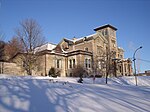McIntyre Medical Sciences Building

The McIntyre Medical Sciences Building is part of the McGill University campus in Montreal, Quebec, Canada. A concrete building built in 1965, it is known for its circular shape. The McIntyre Building is the central hub of the McGill University Faculty of Medicine. Its sixteen floors include classrooms, research facilities, laboratories, offices and a cafeteria. Its design, by Canadian architect Janet Leys Shaw Mactavish of the architecture firm Marshall and Merrett, is meant to reduce traffic and circulation between rooms.Its position on the sloping side of Mount Royal, and the requirement for there to be two entrances at different levels (ground and 6th floors), made it a difficult architectural design site. Its modern circular shape and design, as well as its height amidst the older buildings of the McGill campus, contributed to Montreal's image at the time of the Expo 67 World's Fair. The McIntyre Building, as it is generally known, houses, among other services and departments, the Osler Library of the History of Medicine (named after one of McGill's most famous medical graduates and professors and an icon of modern medicine William Osler) the Departments of Pharmacology & Therapeutics, Biochemistry, Physiology, and Anesthesia. The Life Sciences Library, which was the successor to the McGill Medical library, founded in 1823. was moved to the Schulich Library of Science and Engineering in 2013–2014. It is part of the McGill University Life Sciences Research Complex.
Excerpt from the Wikipedia article McIntyre Medical Sciences Building (License: CC BY-SA 3.0, Authors, Images).McIntyre Medical Sciences Building
Promenade Sir-William-Osler, Montreal Ville-Marie
Geographical coordinates (GPS) Address Nearby Places Show on map
Geographical coordinates (GPS)
| Latitude | Longitude |
|---|---|
| N 45.50315 ° | E -73.58248 ° |
Address
McIntyre Medical Building
Promenade Sir-William-Osler 3655
H3G 1Y6 Montreal, Ville-Marie
Quebec, Canada
Open on Google Maps








